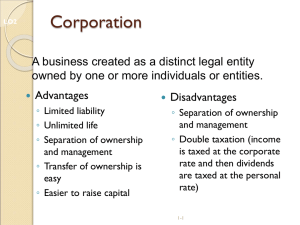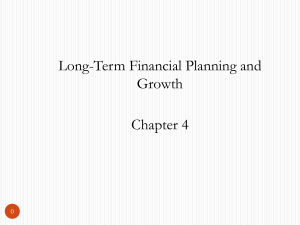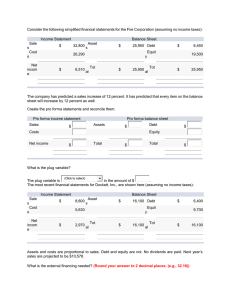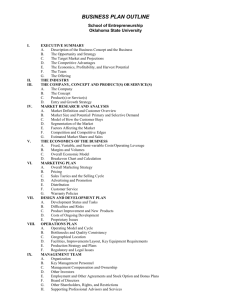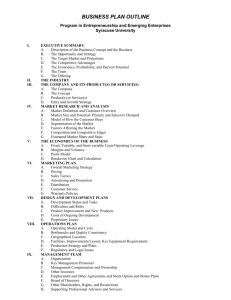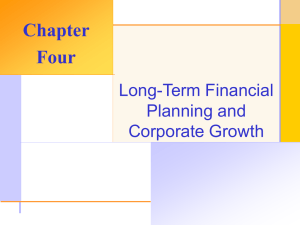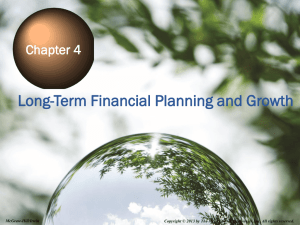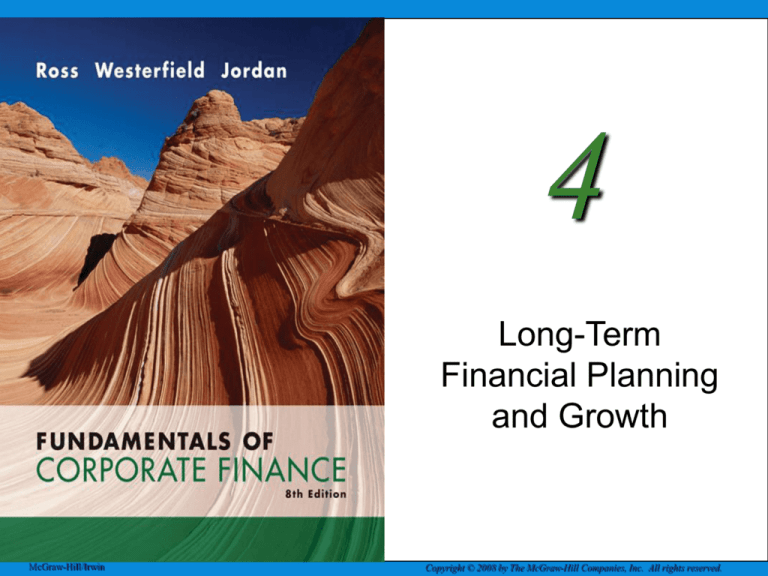
4
Long-Term
Financial Planning
and Growth
McGraw-Hill/Irwin
Copyright © 2008 by The McGraw-Hill Companies, Inc. All rights reserved.
Key Concepts and Skills
Understand the financial planning
process and how decisions are
interrelated
Be able to develop a financial plan using
the percentage of sales approach
Understand the four major decision areas
involved in long-term financial planning
Understand how capital structure policy
and dividend policy affect a firm’s ability
to grow
Chapter Outline
What is Financial Planning?
Financial Planning Models: A First
Look
The Percentage of Sales Approach
External Financing and Growth
Some Caveats Regarding Financial
Planning Models
Elements of Financial Planning
Investment in new assets – determined
by capital budgeting decisions
Degree of financial leverage –
determined by capital structure decisions
Cash paid to shareholders – determined
by dividend policy decisions
Liquidity requirements – determined by
net working capital decisions
Financial Planning Process
Planning Horizon - divide decisions into shortrun decisions (usually next 12 months) and
long-run decisions (usually 2 – 5 years)
Aggregation - combine capital budgeting
decisions into one big project
Assumptions and Scenarios
Make realistic assumptions about important
variables
Run several scenarios where you vary the
assumptions by reasonable amounts
Determine at least a worst case, normal case, and
best case scenario
Role of Financial Planning
Examine interactions – help management see
the interactions between decisions
Explore options – give management a
systematic framework for exploring its
opportunities
Avoid surprises – help management identify
possible outcomes and plan accordingly
Ensure feasibility and internal consistency –
help management determine if goals can be
accomplished and if the various stated (and
unstated) goals of the firm are consistent with
one another
Financial Planning Model
Ingredients
Sales Forecast – many cash flows depend directly on the
level of sales (often estimated using sales growth rate)
Pro Forma Statements – setting up the plan using
projected financial statements allows for consistency and
ease of interpretation
Asset Requirements – the additional assets that will be
required to meet sales projections
Financial Requirements – the amount of financing
needed to pay for the required assets
Plug Variable – determined by management deciding
what type of financing will be used to make the balance
sheet balance
Economic Assumptions – explicit assumptions about the
coming economic environment
Example: Historical Financial
Statements
Gourmet Coffee Inc.
Balance Sheet
December 31, 2006
Assets 1000 Debt
400
Gourmet Coffee Inc.
Income Statement
For Year Ended December
31, 2006
Revenues
Equity
Total
1000 Total
600
1000
2000
Less: costs
(1600)
Net Income
400
Example: Pro Forma Income
Statement
Initial
Assumptions
Revenues will grow
at 15% (2,000*1.15)
All items are tied
directly to sales and
the current
relationships are
optimal
Consequently, all
other items will also
grow at 15%
Gourmet Coffee Inc.
Pro Forma Income
Statement
For Year Ended 2007
Revenues
2,300
Less: costs
(1,840)
Net Income
460
Example: Pro Forma Balance
Sheet
Case I
Dividends are the plug
variable, so equity
increases at 15%
Dividends = 460 NI – 90
increase in equity = 370
Gourmet Coffee Inc.
Pro Forma Balance Sheet
Case 1
Assets
Equity
Total
Case II
Debt is the plug variable
and no dividends are paid
Debt = 1,150 – (600+460)
= 90
Repay 400 – 90 = 310 in
debt
1,150 Debt
1,150 Total
460
690
1,150
Gourmet Coffee Inc.
Pro Forma Balance Sheet
Case 1
Assets
1,150 Debt
90
Equity
Total
1,150 Total
1,060
1,150
Percent of Sales Approach
Some items vary directly with sales, while others do not
Income Statement
Costs may vary directly with sales - if this is the case, then the
profit margin is constant
Depreciation and interest expense may not vary directly with
sales – if this is the case, then the profit margin is not constant
Dividends are a management decision and generally do not vary
directly with sales – this affects additions to retained earnings
Balance Sheet
Initially assume all assets, including fixed, vary directly with sales
Accounts payable will also normally vary directly with sales
Notes payable, long-term debt and equity generally do not vary
directly with sales because they depend on management
decisions about capital structure
The change in the retained earnings portion of equity will come
from the dividend decision
Example: Income Statement
Tasha’s Toy Emporium
Pro Forma Income Statement,
Income Statement, 2006
2007
5,500
% of Sales
Sales Less: costs
(3,300)
Tasha’s Toy Emporium
Sales
Less: costs
5,000
(3,000)
EBT
2,000
Less: taxes
(40% of
EBT)
(800)
Net Income
1,200
Dividends
600
Add. To RE
600
60%
EBT
2,200
Less: taxes
(880)
40% Net Income
16%
Dividends
1,320
Add. To RE
660
24%
660
Assume Sales grow at 10%
Dividend Payout Rate = 50%
Example: Balance Sheet
Tasha’s Toy Emporium – Balance Sheet
Current
% of
Sales
Pro
Forma
Current % of
Pro
Sales Forma
Liabilities & Owners’ Equity
ASSETS
Current Assets
Current Liabilities
Cash
$500
10%
$550 A/P
$900 18%
$990
A/R
2,000
40
2,200 N/P
2,500
n/a
2,500
Inventory
3,000
60
3,300
Total
3,400
n/a
3,490
5,500
110
6,050 LT Debt
2,000
n/a
2,000
CS & APIC
2,000
n/a
2,000
RE
2,100
n/a
2,760
4,100
n/a
4,760
Total
Owners’ Equity
Fixed Assets
Net PP&E
4,000
80
4,400
Total Assets
9,500
190
10,450
Total
Total L & OE
9,500
10,250
Example: External Financing
Needed
The firm needs to come up with an
additional $200 in debt or equity to make
the balance sheet balance
TA – TL&OE = 10,450 – 10,250 = 200
Choose plug variable ($200 external fin.)
Borrow more short-term (Notes Payable)
Borrow more long-term (LT Debt)
Sell more common stock (CS & APIC)
Decrease dividend payout, which increases
the Additions To Retained Earnings
Example: Operating at Less than Full
Capacity
Suppose that the company is currently operating at 80%
capacity.
Full Capacity sales = 5000 / .8 = 6,250
Estimated sales = $5,500, so would still only be operating at
88%
Therefore, no additional fixed assets would be required.
Pro forma Total Assets = 6,050 + 4,000 = 10,050
Total Liabilities and Owners’ Equity = 10,250
Choose plug variable (for $200 EXCESS financing)
Repay some short-term debt (decrease Notes Payable)
Repay some long-term debt (decrease LT Debt)
Buy back stock (decrease CS & APIC)
Pay more in dividends (reduce Additions To Retained
Earnings)
Increase cash account
Work the Web Example
Looking for estimates of company
growth rates?
What do the analysts have to say?
Check out Yahoo Finance – click the
web surfer, enter a company ticker
and follow the “Analyst Estimates”
link
Growth and External Financing
At low growth levels, internal financing
(retained earnings) may exceed the
required investment in assets
As the growth rate increases, the internal
financing will not be enough and the firm
will have to go to the capital markets for
money
Examining the relationship between
growth and external financing required is
a useful tool in long-range planning
The Internal Growth Rate
The internal growth rate tells us how much the
firm can grow assets using retained earnings as
the only source of financing.
Using the information from Tasha’s Toy
Emporium
ROA = 1200 / 9500 = .1263
B = .5
ROA b
1 - ROA b
.1263 .5
.0674
1 .1263 .5
6.74%
Internal Growth Rate
The Sustainable Growth Rate
The sustainable growth rate tells us how much
the firm can grow by using internally generated
funds and issuing debt to maintain a constant
debt ratio.
Using Tasha’s Toy Emporium
ROE = 1200 / 4100 = .2927
b = .5
ROE b
1 - ROE b
.2927 .5
.1714
1 .2927 .5
17.14%
Sustainabl e Growth Rate
Determinants of Growth
Profit margin – operating efficiency
Total asset turnover – asset use
efficiency
Financial leverage – choice of
optimal debt ratio
Dividend policy – choice of how
much to pay to shareholders versus
reinvesting in the firm
Important Questions
It is important to remember that we are
working with accounting numbers and
ask ourselves some important questions
as we go through the planning process
How does our plan affect the timing and risk
of our cash flows?
Does the plan point out inconsistencies in
our goals?
If we follow this plan, will we maximize
owners’ wealth?
Quick Quiz
What is the purpose of long-range planning?
What are the major decision areas involved in
developing a plan?
What is the percentage of sales approach?
How do you adjust the model when operating
at less than full capacity?
What is the internal growth rate?
What is the sustainable growth rate?
What are the major determinants of growth?
4
End of Chapter
McGraw-Hill/Irwin
Copyright © 2008 by The McGraw-Hill Companies, Inc. All rights reserved.
Comprehensive Problem
XYZ has the following financial information for
2006:
Sales = $2M, Net inc. = $.4M, Divs. = .1M
C.A. = $.4M, F.A. = $3.6M
C.L. = $.2M, LTD = $1M, C.S. = $2M, R.E. =
$.8M
What is the sustainable growth rate?
If 2007 sales are projected to be $2.4M, what is
the amount of external financing needed,
assuming XYZ is operating at full capacity, and
profit margin and payout ratio remain constant?

